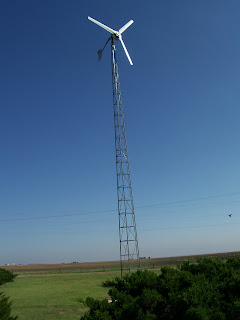As promised, here is more on Turbines Over Texas and my visit with a local duo who is manufacturing residential turbines. Check out our previous blog entry for pictures of the turbine,
Turbines Over Texas.
FOR IMMEDIATE RELEASE
Contact:
Caprock Plains Wind Energy Association
Kelly Ayers, Executive Director
(806) 983-2793
Kelly.j.ayers@gmail.com
Residential Turbines Going up Over the Texas Panhandle
FLOYDADA, Texas, June 17, 2010 – Jesse Mendoza had only had his small residential turbine up at his house east of Hale Center, Texas, for a week and several interested locals had already stopped to question its use.
The turbine at Mendoza’s house is one of many that was designed and constructed in the area. Mendoza, a local DPS trooper, has been working with Randy Craig, a veterinary surgeon and professor of biology at Wayland Baptist University in Plainview, Texas, for several years trying to come up with an inexpensive, residential turbine that could save locals money on their electric bill. One of the pair’s active, operating wind turbines has been up for several years at Craig’s home west of Petersburg which also serves as their manufacturing location.
“We’ve learned and made a lot of mistakes; it probably took twenty prototypes to get to this one,” Craig said. “We’re a fledgling, un-marketed, couple of country boys in a barn company.”
It’s really nothing new for Craig, who Mendoza describes as the “brains” of the operation; Craig has been interested in wind for years. He serves as vice president of the board of directors at the American Wind Power Center and Museum in Lubbock. As a matter of fact, his father was one of the original wind mill enthusiasts of the museum. Craig has spent the last three years working with residential turbines and perfecting the model that is now going up across the South Plains.
The group is operating under the name Turbines Over Texas and while they haven’t done much to market their product just yet, word has been spreading fast. The pair received a lot of attention when they set up their turbine at Caprock Plains Wind Energy Association’s (CPWEA) Wind Expo in March.
The turbine at Mendoza’s house is positioned just inside his circle drive surrounded by a row of shrubbery, like it was always supposed to be there. The turbine stands roughly 51 feet tall to the top of the blade (44 feet to the center of the propeller) and on most days is busy spinning and covering a good part of Mendoza’s electric bill.
The turbine is hooked up to a bidirectional meter that allows it to power Mendoza’s house as well as sell any excess power back to the grid. The turbine is estimated to generate 6,000 to 8,000 kWh per year, but the Turbines Over Texas team is optimistic that it will create more than that.
“You have to look at it over an average of a year, because on one day the wind may not blow at all,” Mendoza said. “I’m very optimistic thinking that it will produce 10,000 to 12,000 kWh in a year.”
To describe the system as simple as possible, the turbine, when generating electricity, will power the house and charge back up batteries with any excess. When the wind slows down, or in the event of a power loss, the house can be powered by the charged batteries. Any electrical deficiencies are then covered by the grid. When the turbine produces excess power, not used to power Mendoza’s house, the additional power is sold back to the electrical company that operates the power grid.
The Turbines Over Texas group has created this small turbine to be sold at a lower price than similar models on the market. Mendoza and Craig were both proud to say that all of the turbine’s parts come from Texas, most of them locally.
The duo had important advice for anyone who thinks they might be interested in getting involved with small wind. If you are working with a large scale developer make sure and check your lease closely; some developers put a clause in their lease which restricts a landowner from putting up a small wind generator which isn’t purchased directly from the large scale wind developer.
The turbine at Mendoza’s house is connected through Lighthouse Electric Cooperative, a customer-owned electric utility with over 4,000 miles of line throughout 12 counties in the Panhandle, South Plains and Rolling Plains regions of Texas. Bruce Sisk, a master electrician and owner of S&S Electric, has been working with the group installing the turbines and getting them connected. If you are interested in having a Turbines Over Texas residential turbine at your house or business you can contact S&S Electric at (806) 293-9849.
CPWEA is a non-profit association working to connect landowners and local businesses with the wind industry. CPWEA is also interested in helping interested parties stay informed about small wind. Go to http://www.caprockplainswind.com to find out more about our association and how you can help support our cause.
###
CPWEA would be more than happy to point you in the right direction if you have questions about small wind, just give us a call or shoot an email our way.
Until next time...












